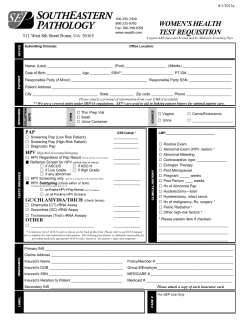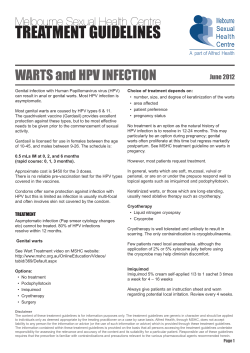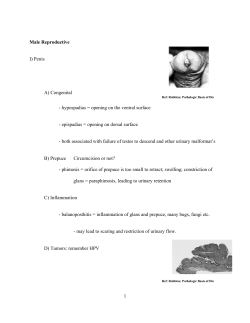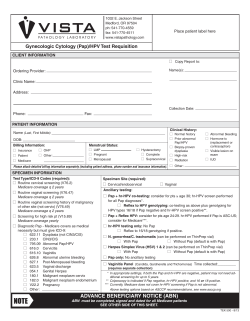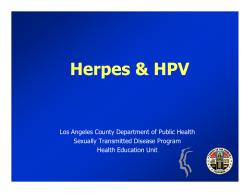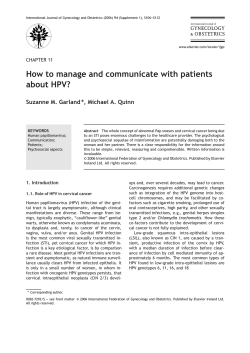
HPV A guide for practitioners papscreen.org.au
HPV A guide for practitioners Human papillomavirus ›› Human papillomavirus (HPV) is critical in the pathogenesis of cervical cancer. We now have reliable tests to detect HPV DNA. ›› Genital HPV infection is usually transient and most often asymptomatic. It is highly contagious and most people acquire infection within a few years of becoming sexually active. ›› Of the 50 genital HPV types, 15 are classified as ‘high-risk’ as they are associated with ano-genital cancer (including squamous and adenocarcinoma of the cervix). ›› The high-risk HPV types 16 and 18 cause 70% or more of cervical cancers. However, while HPV is an extremely common genital infection, ano-genital cancer is actually a rare outcome of its acquisition. ›› The immune system clears the virus within one to two years in the majority of those infected with genital HPV, but persistent infection with a high-risk HPV type (especially HPV 16) is associated with a significantly elevated risk of developing highgrade cellular abnormalities on the cervix. ›› There are many ‘low-risk’ HPV types, the most significant of which are types 6 and 11 as these are responsible for around 90% of genital warts. Low risk HPV types do not cause anogenital cancers but are often associated with low-grade squamous intraepithelial lesions (LSIL) on Pap tests. An LSIL Pap test report is often indicative of an acute HPV infection. HPV testing ›› The purpose of HPV testing is to detect the presence of high-risk HPV types associated with high-grade squamous intraepithelial lesions (HSIL) and cervical cancer. HPV testing is very sensitive and is considered a useful tool for predicting which women with a history of HSIL are at greatest risk of recurrence. ›› NHMRC guidelines do not currently recommend HPV testing for women with LSIL changes. While these women can be offered HPV testing at their own expense, it is important to note that testing positive for a high-risk HPV type will not necessarily change the recommended management and may only serve to exacerbate patient anxiety. papscreen.org.au HPV testing post-HSIL treatment ›› NHMRC Guidelines for the management of asymptomatic women with screen detected abnormalities (2005) recommend that women treated for biopsy-confirmed HSIL should be followed up with a Pap test and colposcopy four to six months after treatment. ›› Cervical cytology plus HPV testing should then be performed 12 months post treatment, and annually thereafter until both tests are negative on two consecutive occasions. These women can then return to the routine cervical screening interval. 4 to 6 months after treatment 12 months after treatment 24 months after treatment Pap test and colposcopy Both negative Pap test and HPV test Both negative Pap test and HPV test Both negative HPV TEST OF CURE COMMON SCENARIOS FOR PATIENTS WITH HSIL Scenario one 4 – 6 months after treatment 12 months after treatment 24 months after treatment Pap test and colposcopy Both negative Pap test and HPV test Both negative Pap test and HPV test Both negative Outcome Return to two-yearly screening. Scenario two 4 – 6 months after treatment Pap test and colposcopy Both negative 12 months after treatment Pap test and HPV test Pap test negative, HPV test positive If at any point the Pap test is reported as HSIL, refer back for colposcopy. Outcome Pap test and HPV test should be conducted 12 months later and then annually until both tests are negative on two consecutive occasions. If at any point the Pap test is reported as LSIL, repeat both tests in 12 months. Scenario three 4 – 6 months after treatment If at any point the HPV test is positive, even in the absence of HSIL, repeat both tests in 12 months. Medicare rebates for HPV testing HPV tests following treatment of a biopsy-confirmed high-grade lesion are covered by Medicare (item number 69418). Medicare will pay for two HPV tests in an on-going 24 month period (until two consecutive negative Pap and HPV tests have been reported, at which point the woman can return to Pap tests at the routine interval). Need more information? Women and health professionals who have questions about Pap tests, HPV or cervical cancer can visit papscreen.org.au or call the Cancer Council Helpline on 13 11 20. Pap test and colposcopy Both negative 12 months after treatment Pap test and HPV test Pap test positive (LSIL), HPV test negative Outcome Pap test and HPV test should be conducted 12 months later and then annually until both tests are negative on two consecutive occasions. Scenario four 4 – 6 months after treatment Pap test and colposcopy Both negative 12 months after treatment Pap test and HPV test Pap test negative, HPV test positive 24 months after treatment Pap test and HPV test Pap test positive (HSIL), HPV test positive Outcome Refer to colposcopy as per NHMRC guidelines (2005). The above four scenarios are based on the NHMRC guidelines, but do not take into account every possible situation. Doctors should use discretion in situations not outlined above. Genital HPV Explaining the facts to women SUGGESTED PHRASES TO EXPLAIN HPV TO WOMEN What is genital HPV? ›› HPV is a virus that is passed on during genital skin-to-skin contact. ›› It is extremely common in men and women who have ever had sex. ›› Some types of HPV cause genital warts, but most HPV infection is invisible. ›› HPV is usually cleared by the body’s immune system in one to two years. HPV and cervical cancer ›› Although most HPV infection is cleared from the body, some types (especially HPV types 16 and 18) are more likely to be persistent and can then cause cell changes on the cervix. These cell changes can usually be found on Pap tests and can be treated. If left untreated, they may develop into cervical cancer. ›› Some HPV types (especially types 6 and 11) cause genital warts. These do not cause cancer. HPV transmission and Pap tests ›› The virus enters the body through tiny breaks in genital skin; it is not spread via blood. ›› A Pap test can detect cell changes caused by HPV. Low-grade squamous intra-epithelial changes (LSIL) ›› Low-grade abnormalities almost always represent shortterm HPV infection. The majority of these changes clear naturally over one to two years without treatment. Treatment of HPV ›› Treatment of the virus itself is not needed as your body’s immune system usually clears the infection. Antibiotics do not treat HPV infection. ›› If infection persists and causes cell changes, these can be treated. Re-infection ›› You are highly unlikely to be re-infected with the same type of HPV, as your body will usually develop immunity to it. However, you can be infected with new types. papscreen.org.au CHECK LIST FOR EXPLAINING HPV HPV and sexual history ›› People can have HPV for a long time without ever knowing it. It may have been acquired many years ago. Do I need to abstain from sex if I have HPV? ›› There is no reason to stop having sex if your Pap test shows HPV-related changes. Condoms and HPV ›› Condoms offer limited protection against HPV as they do not cover all of the genital skin. However, they do provide excellent protection against infections such as chlamydia and are recommended in new sexual relationships. Should I have an HPV test? ›› HPV tests are currently only recommended for women who have had treatment for a confirmed high-grade abnormality. In these cases we look for clearance of HPV so that women can return to the routine Pap screening interval. Medicare covers the cost of HPV testing for these women. If the test is taken in other circumstances it will cost around $60 to $100 depending on which laboratory it is sent to. Will an HPV test determine if I will benefit from having the vaccine? ›› No. The HPV test will only detect if a high-risk HPV type is present at the time of the test. It won’t tell you whether you have had a high-risk type in the past that you have cleared from your body. The HPV vaccine ›› The vaccine prevents infection with the HPV types that cause genital warts and around 70% of cervical cancers. ›› It is most effective if given to boys and girls prior to the onset of sexual activity. In Australia, boys and girls are offered the three-dose course of the HPV vaccine at school. ›› The vaccine is less effective for people who are already sexually active as they may well have already been exposed to the HPV types in the vaccine. Vaccinated women should continue having Pap tests. ›› For more information visit hpvvaccine.org.au ›› Reassure women that low-grade changes are common, usually transient and can safely be monitored for 12 months. ›› Normalise the virus: HPV has been referred to as the ‘common cold of sexual activity’. Using this analogy can be useful when explaining why it is seldom necessary to refer a woman for colposcopy after an initial LSIL report. It is best to give the body’s immune system a chance to resolve infection first. ›› Use the terminology ‘low-grade’ and ‘high-grade’ abnormalities. ›› Always try to provide written information. PapScreen Victoria has brochures on HPV for women. ›› Explain the process to enable the return to two-yearly screening for women who have had a HSIL before the sequence begins. ›› Avoid using terminology such as ‘pre-cancerous’ as it causes anxiety and is usually inaccurate. ›› Avoid using the term ‘test of cure’ with patients. You might want to talk about looking for clearance of high-risk HPV, which will enable the return to routine screening. ›› Direct women to papscreen.org.au – resources for women can also be ordered here. ›› If you have any queries please call the Victorian Cytology Service on 03 9250 0300 and ask to speak to a Liaison Physician. *PapScreen Victoria acknowledges the Victorian Cytology Service for its contribution to this resource. April 2013
© Copyright 2025




